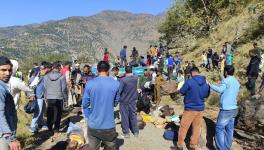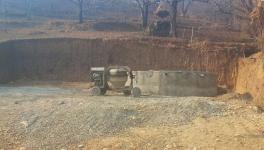With Fresh Order, Jammu & Kashmir Will Lose Its Limited Farmlands
The Union Territory Administration of Jammu & Kashmir recently came up with a strange order by making further changes in the J&K Land Revenue Act 1939 (samvat 1996). This erstwhile state law of Jammu & Kashmir was enacted during the time of Dogra ruler of Kashmir Maharaja Hari Singh. This law continued to be followed post-Dogra regime and even after the abrogation of Article 370 Government of India didn’t repeal it like many other state laws. The government instead made some amendments to this law paving way for the conversion of the agricultural land for non-agriculture activities. To make this happen, the government empowered the District Collector to make these changes which otherwise were only possible at the highest level in the past. Only the Revenue Minister of J&K could allow land conversion in special cases.
As per the Adaptation Order SO 3808 (E) dated 26.10.2020 issued by the Ministry of Home Affairs, Section 133-A was inserted in the J&K Land Revenue Act samvat 1996 which provides restriction on the conversion of agriculture land and process for permission for non-agriculture use. The amendment reads as:
‘Subject to the procedure notified in subsection (4), no land used for agriculture purposes shall be used for any non-agriculture purposes except with the permission of District Collector.’
Under the fresh order issued by Revenue Department on December 28, 2021, vide order No: 174-JK (Rev) of 2021, the government has directed the District Collectors not to give permission for agriculture land conversion for more than 12 ½ standard acres which is equivalent to 100 kanals. This means below 100 kanals collectors can give permission for land conversion.
MEAGRE LAND HOLDING IN J&K
This order is a mere eyewash wherein the government wants to create an impression that they are worried about J&K’s agricultural land. If J&K was like Madhya Pradesh or Rajasthan, the local residents would have appreciated the government’s concern, but ours is a small state which has been divided into two Union Territories post the abrogation of Article 370. So, 12 ½ standard acre or 100 kanals (five hectares) is a huge chunk of land. The farmers of J&K can’t even afford to convert two acres of agricultural land for non-farm activities as our agricultural landholding is very less. This is constantly coming down from the last 20 years and the last five agriculture censuses show a very sharp decline in agricultural landholding in Jammu & Kashmir.
The average size of operational land holdings in India, according to the 2010-11 Agriculture Census, was 1.15 hectares. This figure was lower, at 0.62 hectares, for Jammu & Kashmir and even less for the districts in the Kashmir Valley: Anantnag (0.39 hectares), Kulgam (0.39), Shopian (0.56), Pulwama (0.48), Srinagar (0.31), Budgam (0.43), Baramulla (0.51), Ganderbal (0.37), Bandipora (0.48) and Kupwara (0.51). As per the 2015-2016 Agriculture census, the average operational landholding has come down further. In the 2010-11 census, 46% of farmers in J&K were marginal farmers and this had further increased to 47.5% in 2015-16.
As per the data available with the J&K Revenue Department, out of 24.16 lakh hectare available in J&K, just over nine lakh hectare is the net sown area, which means 37% of the total area of the UT of J&K. In addition, 6.58 lakh hectare area of J&K is under forest cover, which is 27% of the total land area.
When the Adaptation Order SO 3808 (E), dated October 26, 2020, was issued by the Ministry of Home Affairs to make changes in several land laws of J&K, which includes the J&K Land Revenue Act 1996 (samvat), J&K Development Act 1970, J&K Agrarian Reforms Act 1976, J&K Land Grant Act 1960 and some other laws, the Lieutenant-Governor Manoj Sinha and his bureaucrats had made given several assurances that agricultural land of the people will be protected.
Before the amendments in the law, agricultural land could not be converted for non-agriculture purposes, except in special cases and only the State Revenue Minister would grant such permission. The unamended Section 133 A of the J&K Land Revenue Act 1996 reads as:
‘No land which grows or has been growing within the preceding two years 3 [shali (paddy) crop, vegetables, or saffron lullis] shall be used for any purpose other than agricultural purpose, without permission in writing of the Revenue Minister].’
After making the changes the power to grant permission for using the land for non-agricultural activity has been given to the District Collector, which clearly indicates that this policy is aimed at agricultural land conversion rather than its conservation.
Section 133-A of The J&K Land Revenue (amended) Act, 1996 states:
‘No land used for agriculture purposes shall be used for any non-agricultural purposes except with the permission of the District Collector.’
Sub-section 2 of Section 113-A adds that an owner or occupant who wishes to put his agricultural land to non-agricultural use as provided in the regional plan, development plan or master plan as the case may be, ‘shall do so it after payment of conversion charges as prescribed by the Board from time to time.’
This makes amply clear that either with permission of a District Collector or through payment of conversion fee, agricultural land can be used for non-agricultural work. Pertinently the J&K government has already constituted a Board of Revenue last year in August which is headed by Financial Commissioner Revenue with two other members from bureaucracy. The board is the chief controlling authority under the JK Land Revenue Act 1996. This also indicates that government wants to keep all the powers with itself vis-a-vis land laws of Jammu & Kashmir so that at any point in time any changes can be made to facilitate either agriculture land conversion or leasing out state land to non-J&K industrialists and investors?
CHANGES IN J&K DEVELOPMENT ACT 1970
In October 2020, the UT administration, on the direction of the Government of India, amended the J&K Development Act of 1970 and JK Control of Building Operations Act-1988. In addition to other changes, a provision for the creation of a security zone was inserted in the development Act. The law now empowers the government to designate any area as a Strategic Area within lands controlled by any development authority of the J&K Government. The strategic areas thus designated will be the areas reserved for direct operational and training requirements of armed forces. The changes are to be made on the written request of an officer, not below the rank of a corps commander. When these changes were made, political parties of J&K like the National Conference (NC) and Peoples Democratic Party (PDP) expressed their strong resentment. NC had said it was like converting the entire J&K region into a "military establishment."
Transfer of Tourism Land to Army at Gulmarg
Taking the benefit of the changes made in the J&K Development Act 1970 and Building Operations Act 1988, the government recently transferred around 130 acres (1,034 kanals) of land to the Army near the famous hill station of Gulmarg. This land actually belonged to the Gulmarg Development Authority (GDA) which works under the administrative control of the J&K Tourism Department.
This huge chunk of land has been already under the occupation of the Army,1991 onward. In 2012, the then Chief Minister of J&K Omar Abdullah had slammed the Army for grabbing state land at Gulmarg.
The J&K Tourism Department in 2012 had claimed that the Army had not adhered to "all three conditions" of the land deal.
The minutes of the Civil Military Liaison Conference (CMLC), presided over by Chief Minister Omar Abdullah in November 2011 quotes the Principal Secretary Tourism as saying that the Army had not adhered to any condition of the land deal.
As per the agreement, no fresh construction was to be raised by the Army on 53 acres, which was agreed to be surrendered to the J&K government.
‘The Army shall raise fresh constructions on the remaining 77 acres of the land as per by-laws. Besides, the rent shall be paid to the State government and the dilapidated buildings should not be repaired or renovated, the agreement read. It was decided in the CMLC that the Army may consider moving an application before the J&K High Court for seeking permission for carrying out construction activities in the area. Besides, rental compensation will be paid by the Army for the land which is under their occupation’, reads a 2012 news report carried by a local English daily of Srinagar quoting CMLC minutes of meeting.
As per the news report, the Army was under the possession of more than 300 acres, out of which 130 acres had been transferred to the Defence Ministry by State Tourism Department vide Government order number 107-TSH of 1991 dated November 22, 1991. Around 176 acres as per J&K Government under "unauthorised occupation" of Army. It is believed that 130 acres out of 176 acres have now been transferred to the Army through a fresh deal. In the Sonmarg area of the Ganderbal district around 354 kanals of land has been officially transferred to the Army, which was also under their possession for a very long time.
BELOW MARGINAL FARMERS
The majority of the farmers in J&K are officially recognised as marginal farmers as there is very little agricultural landholding. As per the Agriculture census report, the average agriculture landholding in J&K is 0.55 hectares. Unofficial sources say this is much less than this. Farmers having less than one hectare of agriculture landholding are designated as marginal farmers. Even if we say J&K agricultural landholding is equivalent to 0.55 hectares, this means our farmers fall under the category of 'below marginal' farmers. At a time when agricultural land is shrinking day by day, the government’s plan to allow less than 12 ½ standard acres of agricultural land conversion in J&K for non-farm activities like setting up educational institutions, hospitals, factories, industries etc., is completely unrealistic. In such a situation, what is the future of agriculture in J&K, particularly apple farming?
VIOLATION OF LAND USE POLICY
The decisions taken by the government by allowing agricultural land conversion violate the National Land Use Policy 2013. The preamble of the National Land Utilisation policy makes it clear that land is the most important component of people's life support system. The operative part of the preamble under the subheading use of land must be judicious reads as:
‘There is a need for optimal utilisation of land resources. The country can no longer afford to neglect land, the most important natural resource, so as to ensure sustainability and avoid adverse land-use conflicts. There is a need to cater land for industrialisation and for development of essential infrastructure facilities and for urbanisation. While at the same time, there is a need to ensure high-quality delivery of services of ecosystems that come from natural resource base and to cater to the needs of the farmers that enable food security, both of which are of vital significance for the whole nation.’
CONCLUSION
If the Government is really sincere and wants development in Jammu & Kashmir, it needs to focus on J&K’s agricultural economy. Land in J&K is very fertile and even small landholdings give better yields. An apple farmer earns more than Rs 7 lakh as annual income from half-acre land, which is impossible in other states.
The new ultra-high-density apple plants imported from Italy are showing great results. The income of farmers in J&K, especially apple growers, has not only doubled in the last 10 years but has grown three times in many places. The government must put all its efforts to conserve and preserve J&K’s limited farmlands. They must also protect the forest land, which is essential for the environment.
Transferring huge chunks of land in forest areas to defence establishments will be disastrous in the long run. Due to the present policies of the government, which allows farmland conversion, the marginal farmers of J&K will become landless in the next 10 to 15 years.
Raja Muzaffar Bhat is an Acumen fellow. He is Srinagar-based social activist, writer and independent researcher. He is also an Anant fellow for Climate Action. Views are personal.
Get the latest reports & analysis with people's perspective on Protests, movements & deep analytical videos, discussions of the current affairs in your Telegram app. Subscribe to NewsClick's Telegram channel & get Real-Time updates on stories, as they get published on our website.























